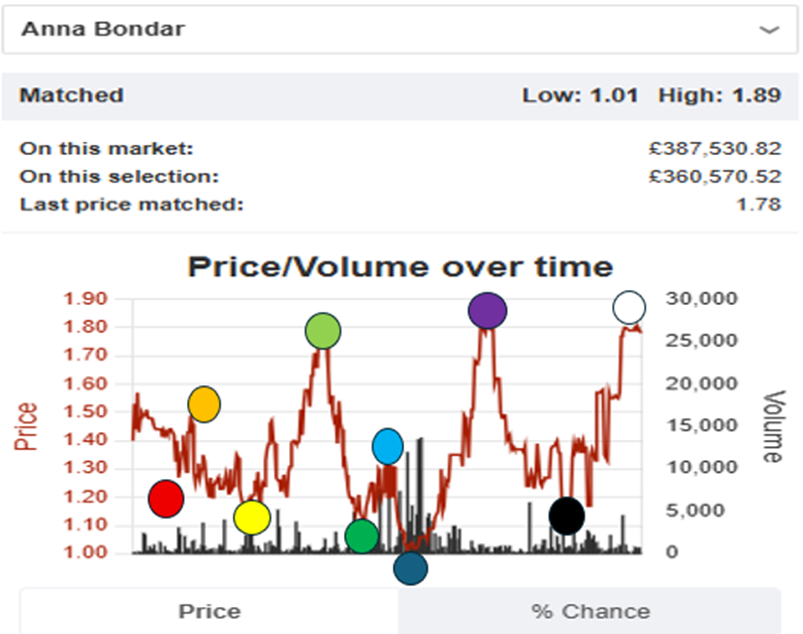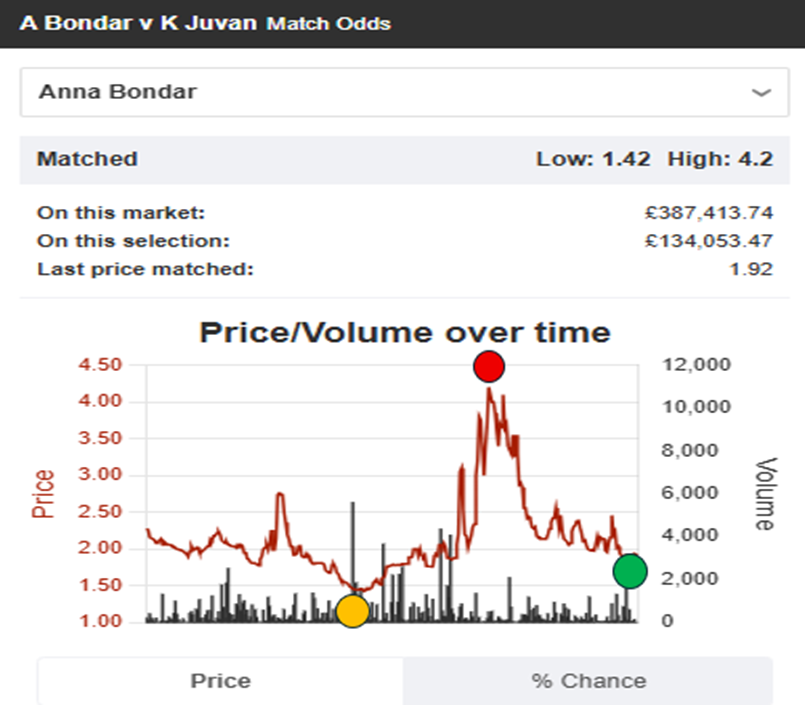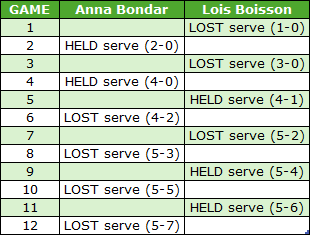 Hi, my name is Dave Renham. I am a maths teacher by day, and in my spare time I bet and trade on horse racing and tennis. I’ve written almost a thousand data-driven articles on racing, many of them on geegeez.co.uk, run by the co-owner of TennisProfits.com, Matt Bisogno. He asked me to share a ‘pilot’ article on tennis, and here it is…
Hi, my name is Dave Renham. I am a maths teacher by day, and in my spare time I bet and trade on horse racing and tennis. I’ve written almost a thousand data-driven articles on racing, many of them on geegeez.co.uk, run by the co-owner of TennisProfits.com, Matt Bisogno. He asked me to share a ‘pilot’ article on tennis, and here it is…
In this first article in a regular (approximately every three weeks) series, I am going discuss tennis betting and/or trading. In recent years tennis betting and trading has grown massively, driven mainly by the live in-play markets where traders can back and lay players as the game is in progress. On Betfair around 90% of all tennis betting comes from in-play betting as compared to pre-match betting, and I am guessing some of the pre-match betting is also traders entering a position.
Tennis lends itself to trading as matches can fluctuate within a single game, let alone a set or indeed a match. Let me use a recent example of such a match, played on 15th July 2025. I was interested in Anna Bondar (ranked 77 in the world) in her last 16 match at the Hamburg Open against the 252 ranked player in the world Noma Noha Akugue.
Below is a screenshot of the Betfair price volatility graph. This was taken when the match was at 6-6 in the final set, just before the match-deciding tie break was due to take place. The reasons I took this screenshot and didn’t wait until the end of the main were two-fold. Firstly, I had finished trading this match and was trading another, and secondly if Bondar had gone on to lose the tie break, the overall match graph would have not shown these match swings as clearly.

I have added some coloured circles to help to explain the movement of the graph at certain points in the match, and I will discuss the graph from left to right outlining the significance of each individual circle.
As we can see the higher ranked player, Bondar, started the match a solid favourite, priced around the 1.45 mark. She broke Akugue’s serve in the first game of the match to drop in price to around 1.26 (red circle).
Bondar was immediately broken back (orange circle) and her price headed back to 1.48. Bondar then broke back immediately and there were no more breaks of serve in the set despite a couple of break points in the seventh game. The yellow circle signifies Bondar’s price when the first set was complete and, having won the set, she dropped to around 1.15.
The play between the yellow and light green circles represents the whole of the second set. Bondar was broken to go 3-1 down but immediately broke back. That explains the graph going up and down (up to 1.48 and back to 1.20), before the steep line going up to the light green circle: this is when the set ended after Bondar was broken in the eighth game and then Akugue successfully served it out. Bondar’s price was 1.78 at the end of the set.
The remaining six circles, from the darker green one, are all positions within the final set. Bondar broke in the second game of the final set and led 3-0. That is where the dark green circle lies, and Bondar’s price went down to 1.10.
Akugue held for 1-3 and had four break points to potentially get back on serve (light blue circle) forcing the price back up 1.34. However, Bondar did eventually hold for 4-1 and then broke again for a 5-1 lead (dark blue circle). Here Bondar, with a double break in the bag, traded on Betfair at the lowest possible price of 1.01. Over £28,000 was traded at this price on the UK exchange.
However, as we can see, the graph sharply moved the other way to the purple circle as Akugue mounted a final set comeback breaking twice and getting the match back to 5-5. Bondar was now trading at 1.89, from 1.01!
Bondar then held to love for 6-5 and forced two match points on Akugue’s serve which is where we see the black circle. Bondar’s price on the match points fluctuated around 1.15, but Akugue eventually held for 6-6 to force the tie break (white circle). Bondar’s price was back up at 1.80 as the tie break started.
For the record, Bondar won the tie break although that fluctuated somewhat, too. She won the first five points, then lost the next three, before closing it out to win 7-3.
*
Even with this match, which was a last-16 encounter between two lower-ranked players, we can see that when the third set tie break started nearly £400,000 had been matched. It shows the amazing liquidity of tennis in-play betting and trading.
This match was a potential goldmine for traders as there were so many large price swings and changes in momentum. The clues were from the start with the first three games of the match being three successive breaks of serve. There were 28 break points in the match: nine in the first set, five in the second set, and 14 in that up and down final set. In reality there were more break points created overall as these numbers only equate to the number of break points that were saved or converted. [On two occasions in the match the server was broken to love, meaning that were a further four break points created although they were never needed to be played out because the returner broke serve at the first attempt when the score was 0-40.]
Of course, to make money trading tennis we have to choose the right entry point and, hence, anyone trading this match could have lost money if not getting that right. Likewise choosing when to close a trade is obviously crucial. However, this match did follow the type of pattern where many of the entry points were fairly standard. Laying the first set winner is one example of a tried and tested method that would have worked well here, as was the cheap lay of the final set double break.
The Akugue match was not the only contest in Hamburg where there was a trading opportunity as far as Bondar was concerned. In her quarter final she was a set and a break down to Alexandrova before breaking twice to level the match at one set apiece. Bondar was broken again in the fourth game of the final set before breaking back and she then broke again to serve for it at 5-4 before Alexandrova broke back. Eventually Bondar won it on a third set tie break.
In Bondar’s semi-final against Kaja Juvan there were seven breaks of serve in the first set! Yes, seven! The screenshot of the Betfair graph shown below was taken at the end of the second set:

The red circle denotes the end of the first set, which Juvan eventually won 7-5. As we see the graph was continually going up and down during that set due to the seven breaks of serve.
The yellow circle denotes when Bondar broke for a 4-2 lead – that was when she traded at her lowest during the first set. Bondar started the second set well, going 3-0 up, which is why the graph drops steeply soon after the red circle. The green circle denotes the end of the second set.
For the record, the third set was fairly uneventful for a Bondar set of tennis: she broke in the first game and held serve for the remainder of the set facing zero break points.
The following day in the Hamburg final she played Lois Boisson, one of the surprising stars of the 2025 French Open where she got through to the semi-finals having been ranked 361 in the world at the time!
The first set of the Hamburg final was another classic Bondar set. It mirrored the Juvan first set in the semi final as there were seven breaks of serve once again:

Bondar was a double break up at 4-0, lost her serve to go 4-2 before regaining the double break at 5-2. She then lost five games in a row to lose the set. Bondar traded at 1.04/1.05 in the First Set market at both 4-0 and 5-2. She went onto lose the second set 6-3 having led 3-1, which means she lost five games in a row at the end of both sets!
Of all the players on the WTA circuit when it comes to trading, Anna Bondar is a player I always look out for in the hope she is playing that week. I hope the matches shared in this article show why this is the case! She does play quite a lot in lower tier tournaments which I usually avoid, but due to some good results at the lower level in 2025 she has started to move back up the rankings. Before the Hamburg tournament she was up to 77, and reaching her first WTA 250 final in the German city saw her move to 59 in the WTA rankings.
Now she is higher in the rankings the chances are she will be entering main tour events over the coming months, which should give us more of her matches to potentially trade. Of course, there will be matches when the swings are not as significant as the ones witnessed in Hamburg, and not all Bondar matches will go to plan trading wise. However, more often than not, with sensible trading decisions, a Bondar match has real potential to turn a good profit.
Every tennis trader has a slightly different approach to how they choose matches to potentially trade. Some – including Tennis Profits members – will have a variety of different strategies to choose from, others may be quite specific and use a relatively narrow approach. Some traders, like me, tend to focus on certain players rather than specific matchups. I would say 75% of the matches I trade involve a player who is on my ‘trading list’. However, regardless of what methodology is used to pick your matches, to be successful at trading it is important to find those that invariably will deliver wider price volatility.
Also, how individual traders approach a match will differ. Some will take a position before the match starts. For example, if a historically weak server is serving first, there is the option to lay the server in the match odds market. If they lose their serve in the first game there is scope to trade out for a small profit straight away. Some traders will take their profit and move straight on to the next match, while others will try to find other entry points in an attempt to take further advantage of the weaker server. In an ideal world the match will be contested between two weak servers who are both good returners making volatility much more likely.
Some traders, on the other hand, wait until later in sets and matches when swings in prices are more significant due to the ‘end game’ effect. This is not a strategy I would suggest for those new to tennis trading, as although the rewards can be attractive the losses are probably going to be painful (unless laying cheaply at very low entry points).
*
For those who have yet to trade tennis matches but are keen, I suggest heading to the ‘Getting Started’ and read all the excellent advice given by Paul Shires. Paul is a highly experienced tennis trader, one of the best. [NOTE: free members can also read the ‘Getting Started’ content. If you’ve never tried Tennis Profits before, take a 21 day trial for just £1 here]
Members of Tennis Profits get the benefit of Paul’s trading thoughts every day. He usually analyses a couple of matches per day with a potential trading plan. Funnily enough, Paul wrote this before the Bondar-Boisson Hamburg final referenced above:
WTA Hamburg
Bondar v Boisson 1.60
Due to start at 1 pm
H2H 1-1. Most recent Apr 2024, clay, Bondar in 2. Boisson won on clay in Feb 2024, 3 sets. Clay win %’s are fairly even.
Bondar needed a 3rd set tie break against Noha in the 1st round as strong favourite. Easy win in the 2nd round as favourite. 3rd set tie break win over Alexandrova as huge underdog in the q final. 3 sets win over Juvan as slight underdog in the semi-final. She reached a CH final in June. 2nd round of the French Open. CH q-final in May. CH title in Aug. Quarter finals in Iasi 2024.
Boisson had an easy win over Grabher in the 1st round. She needed 3 sets against Korpatsch in the 2nd round. 2 sets win over Tomova in the q-final. 2 sets win over Yastremska as underdog in the semis. She reached the Semi-finals at the French Open 2025. 2nd round at Rouen.
12 month and 2025 WTA stats are a little better for Boisson overall. Good chance of 3 sets.
His advice was Back Boisson around 2.10 to 2.30 and remove liability at 1.70.
Anyone following Paul here would have had a very nice winning trade. Boisson actually traded as high as 3.15 when 4-0 down in the first set and her price dropped back below 1.70 as she levelled at 5-5.
*
Before I finish this first piece, I would also encourage potential tennis traders to drill into the plethora of stats available. We can find stats for virtually anything these days – the more bog-standard ones such as first serve percentage, service hold percentage, break of service percentage, break points saved percentage etc. But there are more niche stats here on Tennis Profits which are extremely helpful to traders such as what percentage of the time has a player been broken in their first service game? Or what percentage of the time has a player lost their serve in a set but broken back before the end of the set?
Knowing key stats will aid your trading experience for sure. Understanding the different figures for each tour as well as each player is also important. Men hold serve on average 79.7% of the time on the ATP tour compared to the women on the WTA tour who hold on average 64.9% of the time. Those differences shouldn’t be that surprising, but did you know that on the WTA Challenger tour this drops to 62.7% and on the Women’s ITF tour it drops further to 58.5%?
I hope you’ve enjoyed this first article. I’ll be back in a few weeks’ time with my next contribution. In the meantime, if you have any questions or comments, leave them in the box below. In future articles there will be times when I share key stats and how they can be exploited to potentially give us an edge. Until then, good luck with your betting and trading.
– Dave Renham



Fantastic blog article and a really interesting analysis. Thank you Dave ! I too was following Bondar but didnt quite get a grasp on the price movements but was realising it certainly was going all over the place, but didnt understand why. Now I do ! I look forward to more articles in here. Worth their weight in gold !
Thanks Jon – hopefully other articles will be as useful.
Absolutely fantastic, thanks Dave. I’m new to tennis trading (2 months in) and the hardest thing for me in entry and exit points , exit in particular – the big recovery swings make it hard for a FOMO trader to know when to give up on a position and I end up taking a greater loss sometimes, but I guess that comes with experience?. I’m trying to get to grips with the dynamics of swing trading beyond the normal lay the leader, lay first set winner strategies so this stuff is really helpful.
Thanks Nick. You’ve said the key word ‘experience’ – tennis trading is not something we can rush into. Entry and exit points are so easy after the match! Even the best traders will get entry and exit points wrong from time to time. This is something we have to accept and of course to be successful we need to have that experience that will hopefully mean we choose these points correctly more often than not.
Very enjoyable first edition of the blog. It’s great to hear your perspective and some insights to your approach. I look forward to the next one
Hello Dave,
Thanks for this article. Could you please share your matchs selection criterias for tennis trading ? entry points ? exit points ? when do you close your trade ? what is your profit objective ? When to cashout ? when to cut the loss ?
BR
Laurent
Hi Laurant
Future articles will attempt to cover your questions. Unfortunately there is no easy way to decide the best time when to cash out, or when to cut your losses. Comes a bit from experience and understanding how tennis matches can evolve over time. Profit objective is personal really – the trick I think is not to be too greedy.
cheers
Dave
Hi Dave
Good breakdown of Bondar’s fragility. I traded the Alexandrova match quarter-final. Bondar scraped over the line on that one. Twice serving for the match couldn’t get it done then scraped through the tie break leading 5-1, 2 of her last 3 points were very fortuitous net cords.
I also traded the final got in around 2.3. Deliberately didn’t take the higher price because Boisson was clearly not 100%, hampered with the heavy strapping on her left thigh. Bondar was bossing this match, but she struggles with the mental side. Finding herself with a big lead is something she doesn’t deal well with, add to that this being her 1st Final. She couldn’t cope. When she started to miss easy returns which she had been making earlier, Boisson knew she would get her opportunity and when she did, there was only going to be one winner despite her not being 100%.
Main strategy of mine looking for players with a big lead who are mentally weak! These players accrue all this mental baggage which comes back to haunt them in future matches!
Thanks Ray – you are spot on. Some players are very fragile which potentially gives good trading opportunities.
cheers
Dave
Great read, tennis trading is a great opportunity to profit from sports.
so how do i join ????
Hi Bob
Click the trial link on this page: https://tennisprofits.com/
Matt
Hi Dave – Thanks so much for your most interesting article. I too believe that swing trading offers the best potential returns, provided that one can spot the swing points and react in good time. I have hitherto tended to try to spot which player is going to win as the match goes along, then seek opportunities to back them, and lay the opposing player. I now realise that this is far too simplistic … the dominant player at any given point of the match can change many times – illustrated by all those coloured dots on your charts! Watching players’ body language during play, I find, can help get a feel for the mood of the match, and the player motivation. Paul’s Trading Tips are invaluable in setting the scene. Looking forward to your future … keep up the good work! Best wishes, Paul